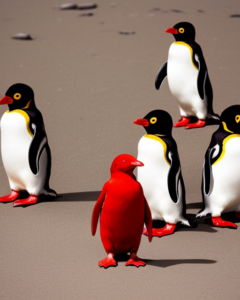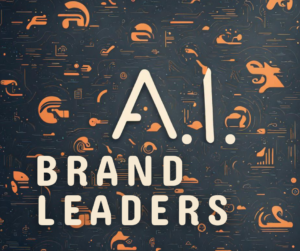consumer and vice versa
(kids play with the toys their parents buy)
while they're new
gets users to stick
in the 21st, they negotiate equity packages
Personality
Vanilla and diamonds can be manufactured in a lab. The replicas are identical in everything except value and perception.
consume something, the less
likely it will be consumed.
Engagement = do they care?
you is your responsibility
you can do as much as
what you can do for them
just perception
no one pays attention
brochure
#CleverDesign
#NotLovingIt
details
proposition
in 4 words
doesn't move
#SmartBranding
Observations, reflections, and ruminations on:
1. Novelty, empathy, and simplicity in product, experience, and communication.
2. How ideas spread, what shapes behavior, and how behavior shapes decisions.
3. Brands, ads, and fads;
the good, the bad, and the entertaining.
“There is no greatness where there is not simplicity, goodness, and truth.”
—Leo Tolstoy
MARKETING
WRITING
Brand Name Domain Social Media Handles
If you're lucky enough to find a clear, pronounceable, and suggestive name that doesn't have a competing brand or an active trademark, don't get discouraged if the domain is unattainable or one of the matching social extensions isn't available.
In a perfect world, every brand would have the same name on every media channel. From the .com website address to Twitter, Facebook, Instagram, and other handles. But these types of Golden Combos are either very rare or very expensive, and finding one might not be worth the effort or expense.
A good name is more important than the right domain and name consistency across channels.
Prompting the genie (talking to AI)
We evolved from storing some information in our brains and books to storing all of it in a cloud. AI helps us retrieve, organize, understand, and utilize this data in many wondrous ways, but retrieving and using it requires a meticulously crafted prompt.
As of 2023, AI doesn’t have a purpose, and it doesn’t know what you’re trying to achieve. To get specific results, you need to define and communicate the desired outcome. The specificity of the explanation will determine the accuracy of the outcome.
Before the advent of mainstream AI, I had my own version of an all-knowing being that complied with my requests only if he understood them...
The Difference Between Brand and Marketing Strategy
Brand strategy is the grand plan. It defines how a brand is going to differentiate, resonate in the mind. It defines the vision, the messaging, and the experience.
The marketing strategy is the tactical plan. It sets the objectives, charts a roadmap, and measures progress.
Brand strategy:
WHAT
- What it looks like, what it says, and what it feels like.
- Positioning, value, and the message that describes it.
WHO
The people who need, want, or will want what the brand offers.
WHY
The reason they want it, choose it, and prefer it.
Marketing strategy:
HOW
The way the message is going to reach the audience.
WHERE
The channels through which the message is going to be delivered.
Brand and marketing strategy complement each other and describe how an idea, product, or service reaches the customer.
(Coming soon)
Can Ai Replace Human Writers?
Artificial intelligence (AI) is an amazing tool, but it will never replace human writers. AI can generate vast amounts of data and detect patterns, but it cannot create the emotional connections that make writing so powerful.
Human writers can use their own experiences, observations, and emotions to create stories that evoke a range of emotions in readers.
AI technology is not capable of producing this kind of writing.
Writers have the unique ability to craft stories that are informed by their life experiences and can relate to readers on a personal level.
AI technology is powerful and helpful, but it cannot replicate the unique power of the human experience.
Lastly, this entire section (up until this paragraph) was "written" by AI.
Were you "fooled"?
How does the writing compare to that of a human?
(Coming soon)
Why is Differentiation Important
Doing what others are doing is not going to get you noticed.
Our brains evolved to notice the unique, novel, or unexpected.
Trite ideas get ignored, repetitive messaging blends with the background, and generic experiences get forgotten.
Without differentiation, no one pays any attention.
An Impactful Value Proposition in 5 Steps
Not to be confused with the tagline and other types of messaging, the value proposition is the sentence that describes what you do, whom it’s for, and why they need it.
A clear value proposition is a fundamental communication tool for businesses and anyone who wants to convey a message.
What people know about you defines their perception and shapes their decisions.
Here are the five steps to creating an impactful value proposition:
1) Do some research, analysis, and soul-searching to answer three main questions in ten words or less. No fluff, only bare facts (brass tacks):
a. What are you selling?
b. Who is your audience?
c. Why would they stand in your line?
2) Synthesize the three into a single sentence that a five-year-old would understand.
For example, the value proposition of this blog is:
WHAT: a succinct explanation of how to create a VP
WHO: for people who want to create and convey a message
WHY: It provides clarity and saves time
VP: A short guide to creating an impactful value proposition
3) Test your value proposition for effectiveness.
Is it:
a. Unique (new, different first to the mind)?
b. Relevant (something people need, want, or care about)?
c. Simple (clear and succinct)?
4) Test your value proposition on people.
Did they understand what you sell and what makes it special?
5) Iterate until they do.
A clearly communicated value proposition is essential to achieving any goal that involves people.
The level of novelty, empathy, and simplicity determines how impactful and effective the VP will be.
Developing a value proposition is an evolving process of listening, developing, and iterating.
Reach out if you could use some help.
Good luck!
(Coming soon)
What is the Accent Color for?
The accent color highlights what the designer wants to draw attention to.
If the background color is the sky, the accent color is the sun.
An increase in quantity decreases uniqueness. The more frequently the color appears, the less attention it attracts. (One red tree in a green forest stands out, but a forest of red trees is a collective property of the forest.)
To be effective, the accent color needs to be used strategically. One drop of the accent color to attract attention where it's needed.
Website Traffic isn't Always a Reliable Metric
Traffic is all the people who somehow get to the website.
It’s possible to find people who would click on anything by sending out emails to unsuspecting victims, but one thing you can’t purchase is intent.
The optimal way to get people to the site (aka traffic) is by providing something truly unique, interesting, and valuable.
Traffic to the site is a vanity metric unless it measures people who reach the site for a reason and eventually become customers.
Find Out What People Think About Your Brand
Have a conversation with them.
If it’s a small business, invite them to a meal or even coffee.
For larger brands, host or sponsor an event. Take the opportunity to make your selected customers feel special while getting an insight into how they feel about your brand.
Qualitative research (customer interviews) provides insight into how real people respond to your brand, product offering, and messaging.
People might not tell you what they really think, and what they say might not reflect how they really feel (intentionally or not). Open your mind, walk a mile in their shoes (especially if your product is shoes), ask open-ended questions, listen, and observe. The truth is usually between the lines and in the body language.
Record the interview (with their permission) and attempt to deduce how they feel about your brand from:
- what they say
- how they say it
- what they’re not saying
Try to avoid biases and be honest with your conclusions.
Good luck!
ANSWERS,
ESSAYS
& OPINIONS
A cheesy value proposition
Innovation doesn’t necessarily require leaps of imagination or millions of dollars in R&D. Some of the most innovative product ideas are simple iterations of existing ones.
The food industry, one of those categories where small changes can lead to large profits, is filled with products that originated as a twist on an existing one and ended up spawning a whole new category.
In 1976, Frank Baker, the son of a growing mozzarella plant owner, came up with an ingenious way to expand the business without significantly increasing costs.To answer demand for personalized cheese snacks, Frank started selling rope-shaped slices of mozzarella. He discovered that soaking the strips in salt brine made them stringy. Packing them individually, Frank created a new product and, eventually, an entire category—string cheese.
Pleasant to look at, easy to hold, and fun to handle, the new snack quickly became a favorite with kids and a staple in many lunch boxes across the US. String cheese found its core audience, and the rest is history.
Population growth, increasing prosperity, and expanding interests create room for never-before-seen products and services. It doesn’t take a leap to create a winning value proposition. Sometimes all it takes is reimagining an existing staple like cheese.
Remote remorse
If I could choose between humans setting up camp in the Metaverse to work and socialize or real-life experience, I would choose the latter.
Given the choice, the mind prefers the simple.
But I believe that real, physical human interaction is too important and useful to sacrifice for convenience.
I was working on my own schedule for a while, often without leaving my home (office), and I quickly learned that solitude, with all of its advantages, is the opposite of what a human like myself needs to prosper.
I realize there are plenty of engineers, coders, and even creatives who don't live in the city and thrive in solitude, but there's another cohort—people like myself—who live in a metropolitan area, can work remotely, and have a people-related job.
To make sure I wasn't the only person who preferred in-person in my cohort, at least, I asked around:
Which do you prefer, and where are you more productive, in the office or at home?
The clear winner was the third option, the hybrid. Most of the people I asked felt more productive and happy overall if they got to have a bit of both.
So what are some of the side effects of working in one's underwear?
A day in the office requires a certain amount of activity that bed-couch migration doesn't, and the home fridge appears to be more accessible than the office kitchenette. But the biggest effect I (and others like me) felt after working remotely for a while wasn't physical, but mental.
Working remotely doesn't necessarily mean working from home. People share office space, work on the proverbial island, and occupy local coffeeshops.
A co-working space is sort of a middle ground, but coffeeshops are on the other side of the spectrum—not optimal for work but highly social. (Even if people "love the vibe," I doubt they would go to an empty coffeeshop.)
A popular coffeeshop scene is a guy or gal in a sweatshirt sitting on a visibly uncomfortable stool, elbows tucked in (like broken chicken wings), typing while balancing the dirty 10-inch table their Mac is placed on.
But the faces and a familiar background noise make it all worthwhile. (It's the reason they're there.)
There's nothing new about it either. Coffeeshops, tea shops, bars, and other places of random congregation were places where ideas were born.
The difference is that today, we don't walk in with another person; we walk in with a laptop. But like a tea shop in Vienna a century ago, we go to coffeeshops to be around people.
It's almost as if an ancient instinct whispers, It's ok, you're among others.
I understand the appeal of online digital interactions. Our brains strive to conserve energy. Being social without dressing up and leaving the house seems appealing, but it also has a downside: you don't get to dress up and leave the house.
Given the option, I never heard people making plans to go out with friends while putting their headsets on.
It could happen, but I hope it won't, at least not until biology catches up with technology.
The bottom line is that humans need to be around other humans.
Let's be human together (more).
How Brands Connect with People
Artists create, then find an audience. Brands find an audience and then create.
You can't connect without first finding, defining, and understanding the people on the other side.
Like in personal relationships, branding and marketing won't "work" unless you say what matters to people who care in a way that connects with them.
For the most part, we connect when we care, and we care when we're being cared for.
Just like people, brands show they care through empathy, intent, effort and attention to the small things (there's nothing bigger).
What is Your Business in a Few Words?
It's often that when I ask people to describe their business in the fewest words possible, they become copywriters all of a sudden.
The idea is to say what one would say unintentionally in a bar or when talking to a 5-year-old (hopefully not on the same occasion). It needs to be unique to capture people's interest, special enough for them to care, and simple enough for anyone to understand.
Don’t use the generic formula; speak from the heart and say what matters to people who care.
If you want the message to spread organically, synthesize your value proposition down to a simple sentence and use it consistently.
Leadership
VS
Popularity
Leadership is not synonymous with popularity.
You're likely wearing one of the most dominant brands in the world without realizing it. YKK's share in the 24 billion zipper market is 40–50% of (similar to Nike's and Coca-Cola's share in theirs.)
An Example of a Premium Value Proposition
I pay $250 each month to the CrossFit franchise.
I know the routines by now, and the equipment can be found in a regular gym. But I derive a lot of benefit, so I end up paying five times the membership of a regular gym.
Value and benefit
- Structure: I know what to expect from each class, and the instructor helps me follow the workout.
- I can “switch off” my brain (at least the analytical side), which vacates my attention to focus on maximizing results.
- Goals and measurable progress increase efficiency
- Fifty-five minutes, four times a week, doesn’t seem like a lot, but if measured as benefit per unit of time, the workout provides more value in less time that the standard gym workout.
- Lastly, we’re pack animals. I could’ve done all of the same exercises on my own time, but the primordial sense of togetherness, competition and camaraderie motivates me to achieve better results.
Paying money to carry heavy things under pressure might seem odd to someone who has made money by carrying heavy things under pressure in the past. It might even seem strange today, but value is subjective, and people like me are willing to pay $250 a month to do some structured manual labor a few times a week.
Stories,
thoughts & observations
Marketing weasels
We're all guilty of using them. Weasel words are unnecessary additions that reflect the author’s state of mind or conversational circumstances more than they add context or information. A mixture of “that's what others are saying” and “heard it somewhere”, with a legal layer of gobbledygook.
When we speak, we sometimes need a few moments to gather our thoughts, and sometimes the listener's impatience applies subconscious pressure, “forcing” the speaker to inject a bridge to cover the silence.
But when it comes to marketing and advertising, an industry where billions of dollars go into communicating and conveying information, there's no excuse for clutter, bridges, or weasels.
The words and phrases in the growing list below are used in traditional advertising, digital campaigns, direct marketing, and other channels. Copywriters use them to advertise pharmaceuticals, food, drink, cars, and everything in between.
Most of this messaging falls on deaf ears because we all know a weasel when we hear one, especially when it's mixed in with some trade jargon.
Sometimes, there's no way around them, but beyond the few weasels here and there, we can (and should) do better.
Eliminating copy weasels forces the writer to be honest, specific, and committed, making the writing more relatable and effective.
This is a call to action to all marketers, advertisers, and anyone else who cares about communication—myself included—let's go easy on transition words, cut the clutter-copy, and get rid of marketing weasels.
Clichés
Whether
Enabling
Facilitate
Disrupting
It's all about us
We're committed
(Such a copout. If you are, say what you're doing about it.)
We're dedicated to
We know
We believe
We recognize
We need to do better
We’re committed (to)
Working closely (with)
Overused and overdone:
Say hello/ Say goodbye
Meet Bob
Redundant and Regurgitated
Redefined
Reimagined
Cringe:
You deserve...
Because (you’re worth it)< /p>
Elevate
Embrace
Unleash
Unlock
Discover
Imagine
Don't tell me what to imagine, make me feel it! (Apologies to Lennon.)
Do you have any additions to the list?
A Sales Pitch or an Advice From a Friend
The people that “sell” us the most are our friends, family, and peers. But not because they actually sell, but because they truly want what's best for us.
The last time I went shopping for some clothes, I encountered two different types of salesmen in two different stores. Here's a snippet of what I think is the difference between a salesman and a helpful friend.
The first salesman felt genuine, helpful, and not too "salesy," as in, I'm happy that you're here, but I'll be fine if you decide to leave. Ironically, it made the product feel more appealing.
We had a casual conversation, and he listened and offered viable solutions to my problem. We talked about fabrics and what they felt like, about trends, and what went well with what. He empathized and answered questions I didn't know I had, while not even trying to "sell to me.".
The second salesman tracked me from the entrance. He wasn't quite there all the time, but I could sense him "hovering" around. He finally found the moment to ask me, in his most formal tone, whether I knew what I liked and knew what I was looking for. (I didn't, hence the visit to the store.)
The main difference between the two salesmen is:
It felt as if the first was genuinely interested in my needs and wanted to help. He knew his stuff, and I felt I could rely on him to tell me what I needed.
The second salesman was nice and knew his stuff as well, but the conversation felt forced and disingenuous. I felt him selling.
(Needless to say, I bought from the first salesman.)
Conclusion:
When you talk to a friend, your passion, conviction, and genuine desire to help "sell" are better than any "sales technique," since what drives you is your friend's benefit rather than a sales commission.
I prefer a genuine recommendation from a friend to a stranger selling to me. How about you?
In How Brands Grow (part 2), Byron Sharp discusses the effects of sharing the Word (in Word Of Mouth—WOM—marketing) on the sharer of the word. In many ways, we convince ourselves on the merits of the product or the brand when we advocate for it to win social credits from the listener. (Jenny is smart, she knows her laptops.). So who's selling to whom really?
There's no selling without caring.
How Profit Sharing Builds Trust
I was involved in sales for the better part of my life, and one thing always bothered me: charging people for my work without them being able to quantify the results ahead of time.
The client felt as if it were a zero-sum game, and I had to establish trust prior to providing value.
The reason: misaligned goals. The seller wants to sell to the client, while the client wants to sell to the end consumer.
I've learned that the best way to increase trust is through a symbiotic relationship.
There are a lot of words, promises, references, examples and convincing arguments, but at the end of the day, the best guarantee is that I want the same thing you want.
Royalties are a mutually beneficial arrangement where both sides get compensated only when goals are met.
I make money only if you make money.
Why We Dislike Rats and Why Details Matter
A rat asks a hamster: Why do you have the reputation of being a cute pet that people feed and keep in their houses, while I, your cousin, have the reputation of being dirty, ugly, and repulsive?
The hamster pondered for a while, stroking his little beard, and then replied:
Perhaps it’s a PR problem.
Insects, worms, and other critters have been depicted as cute and cuddly in media and film. Even the rat's closest sibling, the mouse, was known to be a protagonist. But mice never became the pets that dogs and cats are, and neither did rats.
The obvious reason is that street rats often carry disease and could be dangerous to humans. But I don't practice medicine, and what interested me was how we intuitively know to stay away from rats and not hamsters, for example.
Apparently, it's all about the tail. A hairless tail looks similar to a snake, and our innate reaction is to keep away. (Thousands of years assessing risk in the African savanna nurtured, sometimes irrational, yet life-saving instincts.)
It's almost unfortunate that the tail is such a deal-breaker; it's just a tail after all. But,
The big picture is made from small details
There are many details that seem unimportant on their own (the store's door handles, the number of clicks it takes to complete a purchase, the TP in the restaurant, etc.), but on aggregate, these details make up the customer experience and, by extension, the brand's value.
Next time you consider which details you can forgo, don't forget that for your customer, every detail can be a rat's tail.
How I Got into Copywriting
Words, language, and communication are a lifelong fascination. Changing meaning and perception with a comma was as exciting to me as jumping out of a plane was for a skydiver.
Cleverisms and storytelling run in the family. My dad even has a running list for each family member with their best quotes and gaffes, though I ended up being the first one to get paid for making them.
It started when my friend asked me to help name his business—a kids' dance school.
I was cocky enough to throw ideas around without giving them any thought, but when I did, I realized that a good name should help rather than hinder. Ideally, it should be succinct, meaningful, and easily pronounceable. (Easy on the tongue, easy on the mind.)
After some musing and snoozing, I came up with PrimeStep. (Looking back, the name sounds more serious than it should for a kids' dance school.) My friend loved the name and I enjoyed the learning experience, but I didn't believe I could make a living off it until years later, when timing met opportunity.
The post-recession economy, online platforms and (probably) SharkTank fueled a wave of new businesses in need of a name and a description. Naming evolved into taglines, ad copy and entire websites.
(It also lead to a side hustle: sifting through expired and discarded domains for names with commercial potential and reselling them as brand names.)
For some, writing is a chore; for me, it's a challenge. I enjoy finding ways to describe things in as few words as possible.
Have Your Bidet and Have a Good Day
I was entered into a campaign contest for Tushy once.
My idea: a guy scrubbing himself in the shower with toilet paper. Chunks fall off, and pieces of paper coalesce with body hair to create greasy lumps.
A line reads:
If you’re not using it on your body, why use it on your booty?
I came in second and received $500 and a free Tushy device. Unfortunately, I don’t know who or which idea won.
My next entry was Airbnb’s most unique and eco-friendly concept home contest.
I pitched the Sunflower Home. The anamorphic design and green exterior mimic the stem, and yellow-colored solar panels mimic the petals, opening at sunrise and closing at sunset. The interior is designed in a Fibonacci pattern, with a spiral staircase that leads to a cozy stargazing patio.
I haven’t heard back from Airbnb, but I want to build it even if my concept doesn’t win. I already have a Tushy Bidet for the eco-friendly bathroom.





